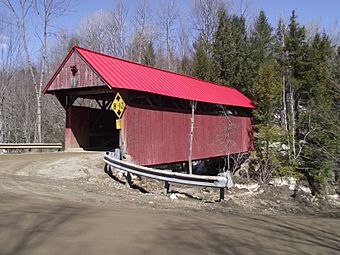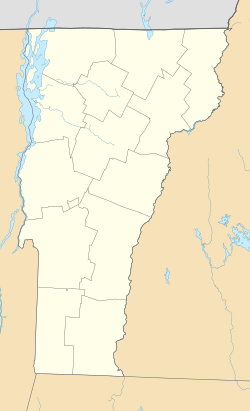Red Covered Bridge (Morristown, Vermont) facts for kids
Quick facts for kids |
|
|
Red Covered Bridge
|
|
 |
|
| Location | Cole Hill Rd. over Sterling Brook, Morristown, Vermont |
|---|---|
| Area | 1 acre (0.40 ha) |
| Built | 1896 |
| Architectural style | queenpost truss |
| NRHP reference No. | 74000232 |
| Added to NRHP | October 16, 1974 |
The Red Covered Bridge is a special old bridge in Morristown, Vermont. It carries Cole Hill Road over a stream called Sterling Brook. This bridge was built way back in 1896. It's the only covered bridge from the 1800s left in Morristown! It's also one of the last covered bridges built in Vermont during the time when many of them were being constructed.
The bridge uses a special design called a queen post truss. Because of its history and unique design, it was added to the National Register of Historic Places in 1974. This means it's an important historical site that needs to be protected.
Contents
Exploring the Red Covered Bridge
The Red Covered Bridge is found in a quiet, countryside part of southwestern Morristown. It's just north of where Cole Hill Road, Sterling Valley Road, and Moren Loop all meet.
How Big Is It?
This bridge has one main section. It is about 64 feet (20 m) long and 18.5 feet (5.6 m) wide. The part where cars drive is about 15 feet (4.6 m) wide, which is just enough for one lane of traffic.
What Does It Look Like?
The bridge has a bright red metal roof. Its outside walls are covered with vertical wooden boards, also painted red. This red siding even goes inside the openings where cars enter and exit. The siding doesn't go all the way up to the roof, leaving a small open space along the top.
The bridge sits on strong supports called abutments. These are made of stone and concrete. The support on the north side even includes a large natural granite rock! In 1971, strong steel beams were added under the bridge deck. These beams help support the weight of cars driving over it today.
The History of This Unique Bridge
The Red Covered Bridge was built in 1896. This makes it one of the very last covered bridges known to be built in Vermont during the 19th century.
Why Is Its Design Special?
The way this bridge was built is a bit unusual. The bottom parts of its truss design, called "bottom chords," are thicker than usual. They are made from twelve layers of wooden planks, making them extra strong. This unique construction helps the bridge stand strong even after all these years.
Covered bridges like this one were built to protect the wooden parts of the bridge from rain, snow, and sun. This helped them last much longer than open bridges.



